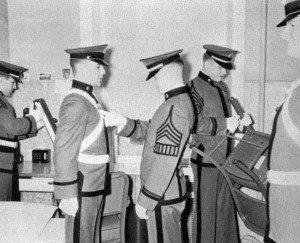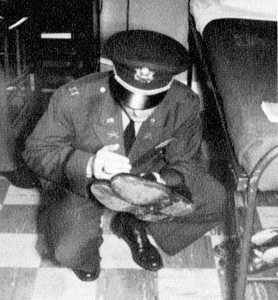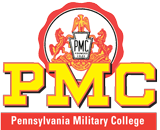 Fourth Classmen (Freshmen), also known as “Rooks,” arrived at PMC with little or no understanding of what they were starting. Their training began almost immediately. Starting in 1961, Rooks moved into Howell Hall, Cann Hall or Turrell Hall. As they did, the Cadre, those upperclassmen charged with Rook training, confronted them with a blizzard of instructions. As the Cadre walked the halls they bellowed instructions on how to organize each room. These now bewildered Rooks learned quickly.
Fourth Classmen (Freshmen), also known as “Rooks,” arrived at PMC with little or no understanding of what they were starting. Their training began almost immediately. Starting in 1961, Rooks moved into Howell Hall, Cann Hall or Turrell Hall. As they did, the Cadre, those upperclassmen charged with Rook training, confronted them with a blizzard of instructions. As the Cadre walked the halls they bellowed instructions on how to organize each room. These now bewildered Rooks learned quickly.
Each room was almost identical. Both the built-in locker and wall locker were to be shared. There were also two desks and bunk beds. Everything had a place and all items had to be displayed exactly as instructed in the “Fourth Class Handbook.” To ensure uniformity for those items that required folding, such as one’s underwear, Rooks were instructed to make cardboard rectangles so that the folded underwear were given a uniform and squared-off appearance. There were even instructions on how to hang items in the wall locker and display unused hangers (all hangers had to face the same direction with the rounded part of the hanger facing outward)! Imagine the look on the faces of Rooks when they learned that there were specific instructions that needed to be followed when putting away their belongings. Where were their mothers?
Throughout the week, daily room inspections were a part of the routine for Rooks. One of the most important items in a room was an index card stuck in the wall plate of the light switch. On this card were the names of the occupants. The card was reversible so that one name appeared at the top. That name was the room orderly for the week. It was the responsibility of the room orderly to keep the floor cleaned, trash emptied and room free of debris during the week. Roommates were responsible for their own belongings.
On Friday, Rooks prepared for the formal white glove inspection Saturday morning. Typically this was a time when Rooks had a chance to relax while they worked. They could walk the hallways in chinos and a t-shirt and were not required to brace or square corners. Rooks quickly learned that Saturday Morning Inspections required a great deal more than what was written in the Regulation Book. Floors were waxed and buffed. For many, learning how to use the unwieldy buffing machines was another new experience. Rooks also learned how to get a high polish on the floor by using a towel under the buffer. At some point during the evening you could find the shower full of Rooks standing with the covers from the heating elements. Brass uniforms buttons had to be cleaned. Windowsills cleaned, shades were placed at half-mast, desk items nearly arranged and the tops and bottoms of shoes cleaned. Saturday morning there was a last minute frenzy to ensure that your bed conformed to the regulations (the blanket needed to be folded 27 inches from the head with 18 inches of sheet exposed with the pillow placed squarely in the space). Of course the blanket needed to be taut enough so that a “quarter could bounce off it” and the hospital corners at the foot of the bed had to be exact. As the call echoed through the hall that the inspecting officers had entered the building, Rooks scrambled to take their positions in their room.
Eventually a loud knock on the door announced the arrival of the inspection team — all wearing white gloves. Standing at attention while inspectors gave each room a rigorous inspection, Rooks were amazed. Their room was clean enough to make any hospital proud. Yet rooms were declared, “Not fit for human habitation” because dirt or dust found on the top of a shoebox, the bottom of a lamp or even in the lamp socket after the bulb was removed. Many Rooks, however, found ways to lighten the situation. Some found spraying  Pledge (spray wax) on the floor made for a very slippery floor and produced many giggles as the inspectors slid. Others doubled-cleaned everything, including the soles of their shoes. Using heel and sole enamel on the bottoms of the shoes was often a way of earning praise or better yet merits.
Pledge (spray wax) on the floor made for a very slippery floor and produced many giggles as the inspectors slid. Others doubled-cleaned everything, including the soles of their shoes. Using heel and sole enamel on the bottoms of the shoes was often a way of earning praise or better yet merits.
Inspectors were known to give an individual a merit or demerit for specific element of the inspection, such as hanging uniforms improperly. If a Rook accumulated enough demerits, they would find themselves marching Penalty Tours on the blacktop between Old Main and Memorial Stadium just below the Commandant’s Office.
These inspections involved all cadets, however, there were several larger purposes. Most important, they promoted teamwork, attention to detail, and a sense of camaraderie among cadets in each company. They also were a component of the 30-week Honor Company Competition. The company earning the best marks was announced each week, adding points toward the overall competition. Honor Company was announced during the Mother’s Day Parade in May and was recognized as the best in the Corps of Cadets.

